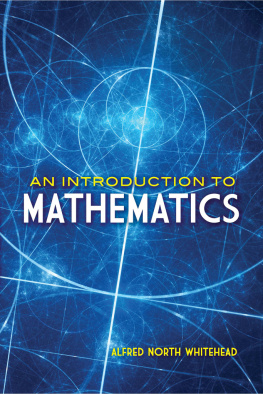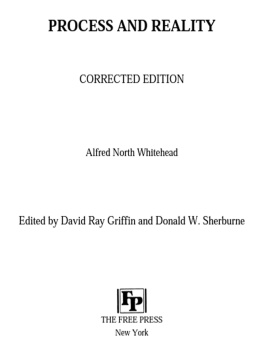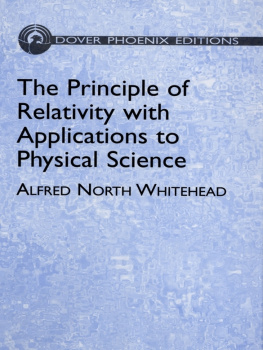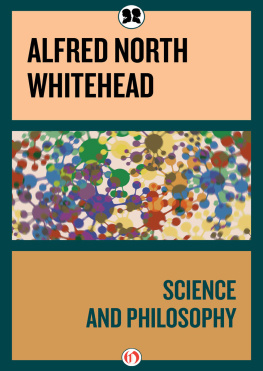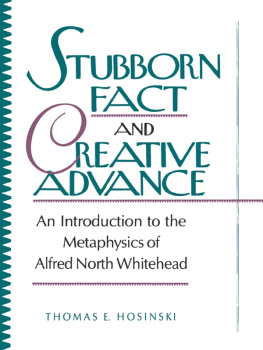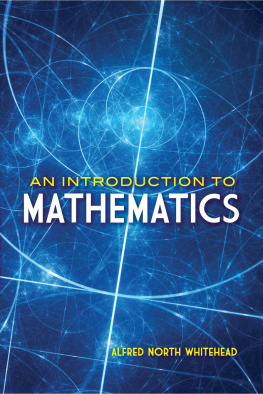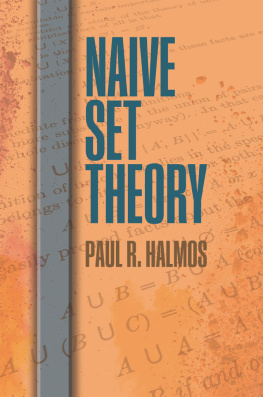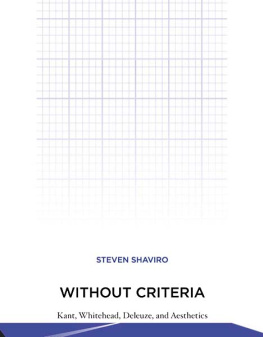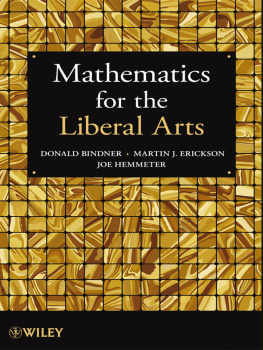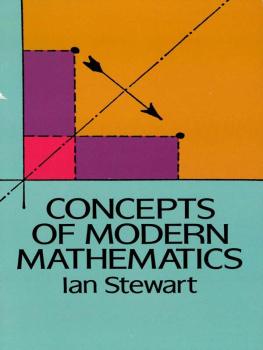AN INTRODUCTION TO
MATHEMATICS
AN INTRODUCTION TO
MATHEMATICS
A LFRED N ORTH W HITEHEAD
DOVER PUBLICATIONS, INC.
MINEOLA, NEW YORK
Bibliographical Note
This Dover edition, first published in 2017, is an unabridged republication of the work originally published in 1911 by Henry Holt & Company, New York.
Library of Congress Cataloging-in-Publication Data
Names: Whitehead, Alfred North, 18611947.
Title: Introduction to mathematics / Alfred North Whitehead.
Description: Dover edition. | Mineola, New York : Dover Publications, Inc., 2017.
Originally published: New York : Henry Holt & Company, 1911. | Includes bibliographical references and index.
Identifiers: LCCN 2016058718| ISBN 9780486813660 | ISBN 0486813665
Subjects: LCSH: Mathematics.
Classification: LCC QA7.W53 2017 | DDC 510dc23 LC record available at https://lccn.loc.gov/2016058718
Manufactured in the United States by LSC Communications
81366501 2017
www.doverpublications.com
CONTENTS
CHAPTER I
THE ABSTRACT NATURE OF MATHEMATICS
T HE study of mathematics is apt to commence in disappointment. The important applications of the science, the theoretical interest of its ideas, and the logical rigour of its methods, all generate the expectation of a speedy introduction to processes of interest. We are told that by its aid the stars are weighed and the billions of molecules in a drop of water are counted. Yet, like the ghost of Hamlets father, this great science eludes the efforts of our mental weapons to grasp it Tis here, tis there, tis gone and what we do see does not suggest the same excuse for illusiveness as sufficed for the ghost, that it is too noble for our gross methods. A show of violence, if ever excusable, may surely be offered to the trivial results which occupy the pages of some elementary mathematical treatises.
The reason for this failure of the science to live up to its reputation is that its fundamental ideas are not explained to the student disentangled from the technical procedure which has been invented to facilitate their exact presentation in particular instances. Accordingly, the unfortunate learner finds himself struggling to acquire a knowledge of a mass of details which are not illuminated by any general conception. Without a doubt, technical facility is a first requisite for valuable mental activity: we shall fail to appreciate the rhythm of Milton, or the passion of Shelley, so long as we find it necessary to spell the words and are not quite certain of the forms of the individual letters. In this sense there is no royal road to learning. But it is equally an error to confine attention to technical processes, excluding consideration of general ideas. Here lies the road to pedantry.
The object of the following chapters is not to teach mathematics, but to enable students from the very beginning of their course to know what the science is about, and why it is necessarily the foundation of exact thought as applied to natural phenomena. All allusion in what follows to detailed deductions in any part of the science will be inserted merely for the purpose of example, and care will be taken to make the general argument comprehensible, even if here and there some technical process or symbol which the reader does not understand is cited for the purpose of illustration.
The first acquaintance which most people have with mathematics is through arithmetic. That two and two make four is usually taken as the type of a simple mathematical proposition which everyone will have heard of. Arithmetic, therefore, will be a good subject to consider in order to discover, if possible, the most obvious characteristic of the science. Now, the first noticeable fact about arithmetic is that it applies to everything, to tastes and to sounds, to apples and to angels, to the ideas of the mind and to the bones of the body. The nature of the things is perfectly indifferent, of all things it is true that two and two make four. Thus we write down as the leading characteristic of mathematics that it deals with properties and ideas which are applicable to things just because they are things, and apart from any particular feelings, or emotions, or sensations, in any way connected with them. This is what is meant by calling mathematics an abstract science.
The result which we have reached deserves attention. It is natural to think that an abstract science cannot be of much importance in the affairs of human life, because it has omitted from its consideration everything of real interest. It will be remembered that Swift, in his description of Gullivers voyage to Laputa, is of two minds on this point. He describes the mathematicians of that country as silly and useless dreamers, whose attention has to be awakened by flappers. Also, the mathematical tailor measures his height by a quadrant, and deduces his other dimensions by a rule and compasses, producing a suit of very ill-fitting clothes. On the other hand, the mathematicians of Laputa, by their marvellous invention of the magnetic island floating in the air, ruled the country and maintained their ascendency over their subjects. Swift, indeed, lived at a time peculiarly unsuited for gibes at contemporary mathematicians. Newtons Principia had just been written, one of the great forces which have transformed the modern world. Swift might just as well have laughed at an earthquake.
But a mere list of the achievements of mathematics is an unsatisfactory way of arriving at an idea of its importance. It is worthwhile to spend a little thought in getting at the root reason why mathematics, because of its very abstractness, must always remain one of the most important topics for thought. Let us try to make clear to ourselves why explanations of the order of events necessarily tend to become mathematical.
Consider how all events are interconnected. When we see the lightning, we listen for the thunder; when we hear the wind, we look for the waves on the sea; in the chill autumn, the leaves fall. Everywhere order reigns, so that when some circumstances have been noted we can foresee that others will also be present. The progress of science consists in observing these interconnections and in showing with a patient ingenuity that the events of this evershifting world are but examples of a few general connections or relations called laws. To see what is general in what is particular and what is permanent in what is transitory is the aim of scientific thought. In the eye of science, the fall of an apple, the motion of a planet round a sun, and the clinging of the atmosphere to the earth are all seen as examples of the law of gravity. This possibility of disentangling the most complex evanescent circumstances into various examples of permanent laws is the controlling idea of modern thought.
Now let us think of the sort of laws which we want in order completely to realize this scientific ideal. Our knowledge of the particular facts of the world around us is gained from our sensations. We see, and hear, and taste, and smell, and feel hot and cold, and push, and rub, and ache, and tingle. These are just our own personal sensations: my toothache cannot be your toothache, and my sight cannot be your sight. But we ascribe the origin of these sensations to relations between the things which form the external world. Thus the dentist extracts not the toothache but the tooth. And not only so, we also endeavour to imagine the world as one connected set of things which underlies all the perceptions of all people. There is not one world of things for my sensations and another for yours, but one world in which we both exist. It is the same tooth both for dentist and patient. Also we hear and we touch the same world as we see.

